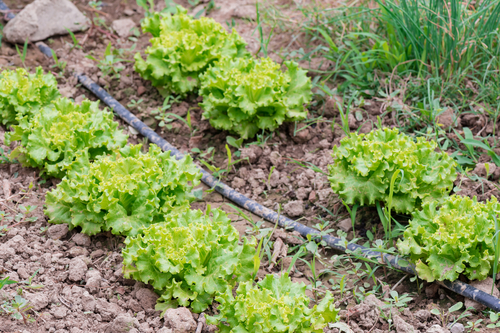Chlorine, Soil, and Watering Gardens

GardenZeus receives commissions for purchases made through links in this post. There is no additional cost to you.
Down and Dirty Southern California Gardening
A weekly GardenZeus article series to help gardeners succeed in Southern California’s unique climates and growing conditions.
This is the first of two articles dealing with watering gardens in urban landscapes.
How serious a problem is chlorine in municipal water for your soil and garden? Despite many scientific studies related to the topic, the answers you receive from other gardeners, experts, and even scientists are likely to be varied and opinionated.
High levels of chlorine in soils are toxic to plants, but research has shown that chlorine at levels typical in municipal tapwater (often around 5 parts per million) have little or no direct effect on plant growth. Many studies also find minimal negative effect on soil microbes, or conclude that microbes are killed only near the soil surface. Chlorine also tends to bind rapidly to soil particles, which leads many gardeners and growers to ignore chlorine in municipal water as a non-issue for plant health and yield.
On the other hand, many organic gardeners and some experts, myself included, consider chlorinated water to be a potentially significant problem for soil-and-plant health.
Growing a control group of plants in dead soil with chlorine-free water, then using chlorinated municipal water for a separate experimental group of plants also grown in similar dead soil with results unsurprisingly showing little or no difference between the two groups doesn’t prove to me that chlorine won’t harm soil life in a thriving soil ecosystem under the local conditions of a home garden. The details and methods of scientific research limit the usefulness of their results, and unfortunately most research I’ve seen related to chlorinated water and soils often seems incomplete or irrelevant to me when it comes to making decisions about using chlorinated water in gardens.
Even if chlorine only kills sensitive microbes or microbes in the upper portion of soil, the loss of those microbes may be significant to the overall health of the soil ecosystem. By this logic, why worry about running over nails and metal debris in your car? All that will happen is that some of your tires will go flat, and tires are only a small part of the car. With potentially billions of organisms per handful of living soil and countless interdependent biological processes occurring continually, the functioning of healthy soil is orders of magnitude more complex than the mechanical operation of a car. Wiping out the top inch or two of soil microbes with chlorinated water could mean killing trillions of organisms in a home garden. The vast majority of soil microbes are directly or indirectly helpful to plants.
Many variables that might be important to understanding chlorine’s effect on soil life have been ignored or not adequately addressed in the research that I’ve seen. A few of these include possible sensitivity or varying effects of chlorine on numerous strains and species of soil microbes, temperature, soil composition, soil texture, and even frequency of soil saturation with chlorinated water.
It’s worth remembering when facing the challenges of using chlorinated municipal water in organic gardens that chlorination almost entirely eliminated deadly water-borne diseases such as cholera, dysentery, and typhoid from municipal water systems in industrialized areas worldwide during the 20th Century, and that chlorine continues to eliminate harmful pathogens, such as E. coli and giardia, in municipal water drawn from natural areas including lakes and reservoirs.
See Part 2 of this series regarding suggestions for removing chlorine: Remove Chlorine When Watering Organic Gardens (Chlorinated Water, Part 2 of 3)
“Down and Dirty Southern California Gardening” is a weekly GardenZeus article series in which expert Darren Butler shares more than 20 years of experience about what works and what doesn’t with gardening in Southern California:
“Summerer” in Southern California’s Coastal Areas (Summerer Part 3)
All articles in this series: Down and Dirty Southern California Gardening
To receive customized gardening advice for your area, enter your zip code here.
It is easy to get started with a new vegetable garden using a raised bed planter: